Global Augmented Reality Market, By Component, By Technology, By Application, By Region & Segmental Insights Trends and Forecast, 2024 – 2034
- Industry: Technology
- Report ID: TNR-110-1099
- Number of Pages: 420
- Table/Charts : Yes
- May, 2024
- Base Year : 2024
- No. of Companies : 10+
- No. of Countries : 29
- Views : 10357
- Covid Impact Covered: Yes
- War Impact Covered: Yes
- Formats : PDF, Excel, PPT
In Terms of Revenue, the Global Augmented Reality Market was Worth US$ 40.92 Bn in 2023 and is Anticipated to Witness a CAGR of 32.69% During 2024 – 2034.
The augmented reality (AR) market has witnessed significant growth, driven by advancements in technology and increasing applications across various sectors. AR overlays digital content onto the real world, enhancing user experiences in fields like gaming, retail, healthcare, and education. The integration of AR in smartphones and wearable devices has broadened its accessibility, fostering consumer engagement and immersive experiences. Key players, including Apple, Google, and Microsoft, are investing heavily in AR innovations, signaling robust market expansion. Enterprise adoption is also rising, with businesses utilizing AR for training, maintenance, and remote collaboration. Despite challenges such as high development costs and privacy concerns, the AR market is poised for substantial growth, projected to reach multi-billion-dollar valuations in the coming years.

Augmented Reality Market Dynamics
Growth Driver- Rapid Advancement in Smartphone Technology
Modern smartphones are equipped with powerful processors, high-resolution cameras, and advanced sensors like accelerometers and gyroscopes, which are essential for AR functionality. These technological enhancements enable smartphones to deliver seamless and immersive AR experiences, making AR more accessible to the general public. Additionally, major tech companies such as Apple and Google are continuously developing and integrating AR software development kits (SDKs) like ARKit and ARCore, simplifying the creation of AR applications for developers. This ecosystem support encourages a proliferation of AR apps across various domains, including gaming, retail, education, and real estate.
As smartphone penetration continues to rise globally, the user base for AR applications expands correspondingly, driving market growth. The continuous evolution in smartphone capabilities thus acts as a catalyst, propelling the widespread adoption and integration of AR technologies in everyday life.
Trends- Increasing Integration of AR in e-Commerce and Retail
Retailers are leveraging AR to create more engaging and personalized shopping experiences. AR allows customers to virtually try on clothes, accessories, or makeup through their smartphones or AR-enabled mirrors in stores. This not only enhances the shopping experience but also reduces the return rates by helping customers make more informed purchase decisions. Major brands like IKEA and Sephora have successfully implemented AR apps, allowing customers to visualize furniture in their homes or experiment with different makeup looks.
Additionally, AR is being used for interactive product demonstrations and virtual showrooms, enabling businesses to showcase their products in innovative ways. This trend reflects a broader shift towards digital transformation in retail, where AR is becoming a crucial tool for driving customer engagement, satisfaction, and ultimately, sales.
Challenge- High Cost of Development and Implementation
Creating sophisticated AR applications requires substantial investment in advanced hardware, software, and skilled developers. The initial costs can be prohibitive for small and medium-sized enterprises, limiting their ability to adopt AR technology. Additionally, developing high-quality AR experiences demands ongoing research and innovation, which can strain resources. The cost of AR hardware, such as AR glasses and headsets, also remains relatively high, restricting widespread consumer adoption. These financial barriers can slow the pace at which AR technology is integrated across various industries.
Moreover, businesses must ensure that their AR solutions are compatible with multiple devices and platforms, adding to the complexity and expense. Overcoming these cost-related challenges is essential for the broader and more inclusive growth of the AR market, requiring strategic investments and perhaps more affordable technological breakthroughs.
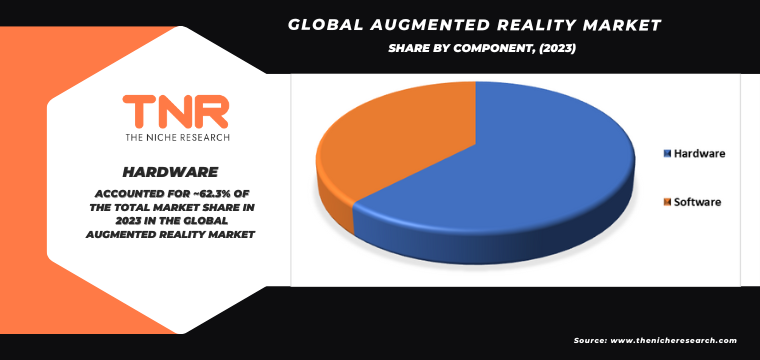
Augmented Reality Market Segmentation by Component, Technology, Application and Region
The hardware segment is poised to assert its dominance in the augmented reality market, boasting a substantial revenue share of 62.3% over the forecast period. Development and sales of AR devices like smart glasses, headsets, and AR-enabled smartphones are driving significant revenue. These devices are essential for delivering immersive AR experiences. Secondly, continuous advancements in AR hardware, such as improved sensors, processors, and displays, enhance user experience and broaden application possibilities. Additionally, the growing adoption of AR hardware in sectors like healthcare, manufacturing, and retail for training, maintenance, and customer engagement further boosts demand, solidifying the hardware segment’s market dominance.
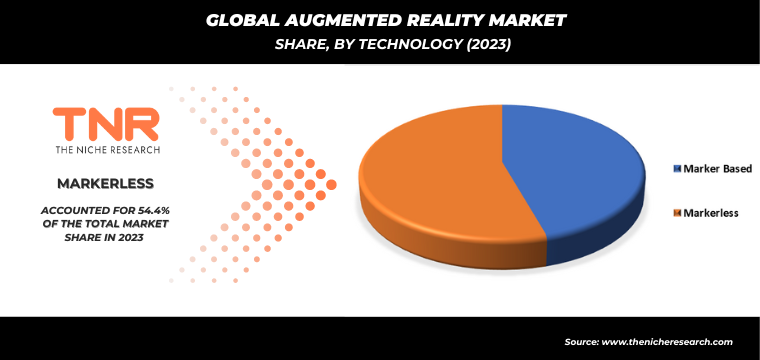
The marker based technology is anticipated as the fastest growing segment in the augmented reality market, boasting a substantial revenue share of 45.6% over the forecast period. This technology uses visual markers, like QR codes or images, to trigger AR experiences, making it cost-effective and simple for developers to create AR applications. It offers precise tracking and recognition, enhancing user interaction and experience. Industries such as retail, education, and marketing increasingly adopt marker-based AR for interactive product displays, educational tools, and immersive advertisements, driving its rapid growth and significant revenue share in the AR market.
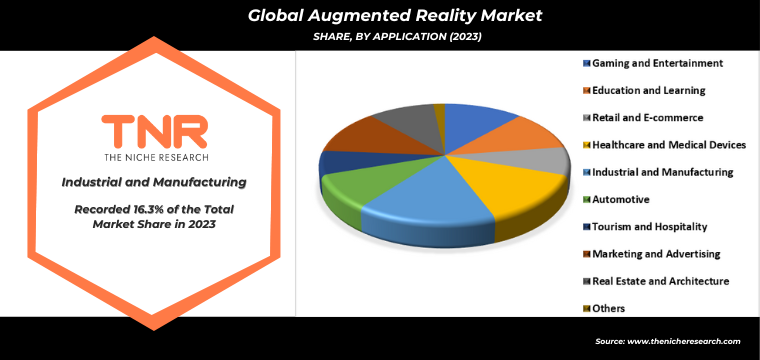
By application industrial and manufacturing segment dominated the augmented reality market, boasting a substantial revenue share of 16.3% over the forecast period. AR enhances productivity and efficiency through applications like maintenance and repair, where real-time, hands-free instructions overlay equipment, reducing downtime and error rates. Training programs benefit from immersive simulations, accelerating skill acquisition and improving safety. Additionally, AR supports complex assembly processes by providing visual guidance, ensuring precision and reducing assembly time. The integration of AR in quality control also enables better defect detection and process optimization, driving widespread adoption and significant revenue in the industrial and manufacturing sectors.
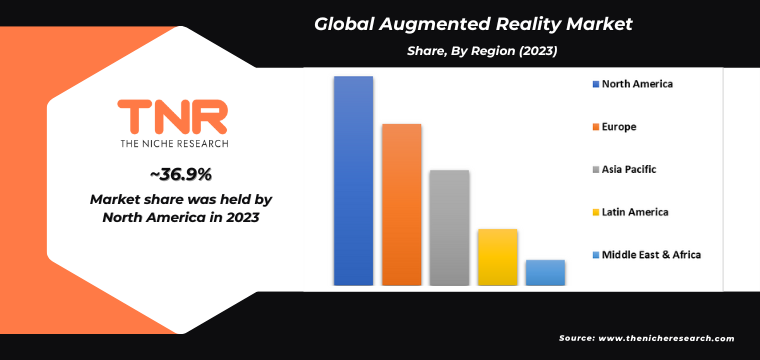
In 2023, North America is anticipated to play a significant role in propelling the growth of the augmented reality market, contributing approximately 36.9% to its overall expansion. The region is home to leading technology companies like Apple, Google, and Microsoft, which are heavily investing in AR innovation and development. There is also a robust ecosystem of AR startups and research institutions fostering advancements in AR technology. High consumer adoption rates of advanced gadgets and a strong demand for immersive experiences across sectors like gaming, retail, and healthcare further fuel market growth. Additionally, substantial funding and supportive government initiatives for AR applications enhance North America’s dominant position in the market.
Key Developments
- In May 2022, Magic Leap, Inc. revealed a strategic partnership with the digital firm Globant. This collaboration is focused on promoting the adoption of augmented reality within enterprises, aiming to broaden the scope of enterprise AR applications.
- In April 2021, Google LLC introduced the WebXR collection to provide an enhanced immersive experience for users. This platform encompasses tools such as Sodar, Measure UP, Floom, and Picturescape, delivering a comprehensive immersive experience specifically for Android users.
Major Players in Augmented Reality Market
- Apple, Inc.
- Blippar Group Limited
- Google LLC
- Lenovo
- Magic Leap, Inc.
- Meta
- Microsoft
- PTC
- Snap, Inc.
- Sony Semiconductor Solutions Corporation
- TeamViewer AG
- Visometry GmbH
- Vuzix
- Wikitude
- Xiaomi
- Zappar Ltd
- Other Industry Participants
Global Augmented Reality Market Key Insights:
| Report Specifications | Details |
| Market Revenue in 2023 | US$ 40.92 Bn |
| Market Size Forecast by 2034 | US$ 951.26 Bn |
| Growth Rate (CAGR) | 32.69% |
| Historic Data | 2016 – 2022 |
| Base Year for Estimation | 2023 |
| Forecast Period | 2024 – 2034 |
| Report Inclusions | Market Size & Estimates, Market Dynamics, Competitive Scenario, Trends, Growth Factors, Market Determinants, Key Investment Segmentation, Product/Service/Solutions Benchmarking |
| Segments Covered | By Component, By Technology, By Application, By Region |
| Regions Covered | North America, Europe, Asia Pacific, Middle East & Africa, Latin America |
| Countries Covered | U.S., Canada, Mexico, Rest of North America, France, The UK, Spain, Germany, Italy, Nordic Countries (Denmark, Finland, Iceland, Sweden, Norway), Benelux Union (Belgium, The Netherlands, Luxembourg), Rest of Europe, China, Japan, India, New Zealand, Australia, South Korea, Southeast Asia (Indonesia, Thailand, Malaysia, Singapore, Rest of Southeast Asia), Rest of Asia Pacific, Saudi Arabia, UAE, Egypt, Kuwait, South Africa, Rest of Middle East & Africa, Brazil, Argentina, Rest of Latin America |
| Key Players | Apple, Inc., Blippar Group Limited, Google LLC, Lenovo, Magic Leap, Inc., Meta, Microsoft, PTC, Snap, Inc., Sony Semiconductor Solutions Corporation, TeamViewer AG, Visometry GmbH, Vuzix, Wikitude, Xiaomi, Zappar Ltd, Other Market Participants |
| Customization Scope | Customization allows for the inclusion/modification of content pertaining to geographical regions, countries, and specific market segments. |
| Pricing & Procurement Options | Explore purchase options tailored to your specific research requirements |
| Contact Details | Consult With Our Expert
Japan (Toll-Free): +81 663-386-8111 South Korea (Toll-Free): +82-808- 703-126 Saudi Arabia (Toll-Free): +966 800-850-1643 United Kingdom: +44 753-710-5080 United States: +1 302-232-5106 E-mail: askanexpert@thenicheresearch.com
|
Global Augmented Reality Market
By Component
- Hardware
- Software
By Technology
- Marker Based
- Markerless
- Location-based AR
- Projection-based AR
- Overlay AR
- Contour-based AR
By Application
- Gaming and Entertainment
- Education and Learning
- Retail and E-commerce
- Healthcare and Medical Devices
- Industrial and Manufacturing
- Automotive
- Tourism and Hospitality
- Marketing and Advertising
- Real Estate and Architecture
- Others
By Region
- North America (U.S., Canada, Mexico, Rest of North America)
- Europe (France, The UK, Spain, Germany, Italy, Nordic Countries (Denmark, Finland, Iceland, Sweden, Norway), Benelux Union (Belgium, The Netherlands, Luxembourg), Rest of Europe)
- Asia Pacific (China, Japan, India, New Zealand, Australia, South Korea, Southeast Asia (Indonesia, Thailand, Malaysia, Singapore, Rest of Southeast Asia), Rest of Asia Pacific)
- Middle East & Africa (Saudi Arabia, UAE, Egypt, Kuwait, South Africa, Rest of Middle East & Africa)
- Latin America (Brazil, Argentina, Rest of Latin America)
Report Coverage:
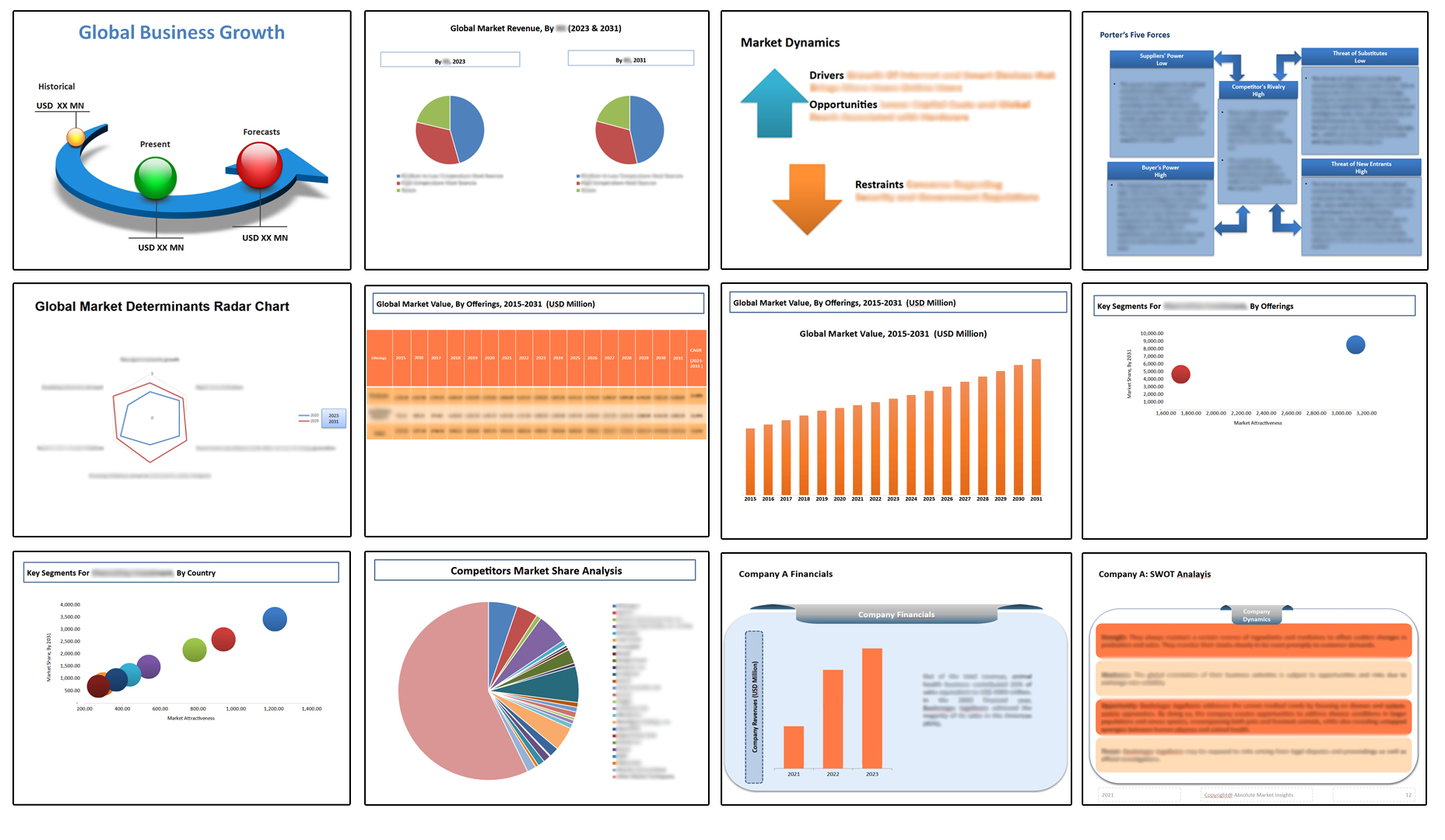
Table of Contents
Note: This ToC is tentative and can be changed according to the research study conducted during the course of report completion.
**Exclusive for Multi-User and Enterprise User.
Global Augmented Reality Market
By Component
- Hardware
- Software
By Technology
- Marker Based
- Markerless
- Location-based AR
- Projection-based AR
- Overlay AR
- Contour-based AR
By Application
- Gaming and Entertainment
- Education and Learning
- Retail and E-commerce
- Healthcare and Medical Devices
- Industrial and Manufacturing
- Automotive
- Tourism and Hospitality
- Marketing and Advertising
- Real Estate and Architecture
- Others
By Region
- North America (U.S., Canada, Mexico, Rest of North America)
- Europe (France, The UK, Spain, Germany, Italy, Nordic Countries (Denmark, Finland, Iceland, Sweden, Norway), Benelux Union (Belgium, The Netherlands, Luxembourg), Rest of Europe)
- Asia Pacific (China, Japan, India, New Zealand, Australia, South Korea, Southeast Asia (Indonesia, Thailand, Malaysia, Singapore, Rest of Southeast Asia), Rest of Asia Pacific)
- Middle East & Africa (Saudi Arabia, UAE, Egypt, Kuwait, South Africa, Rest of Middle East & Africa)
- Latin America (Brazil, Argentina, Rest of Latin America)
The Niche Research approach encompasses both primary and secondary research methods to provide comprehensive insights. While primary research is the cornerstone of our studies, we also incorporate secondary research sources such as company annual reports, premium industry databases, press releases, industry journals, and white papers.
Within our primary research, we actively engage with various industry stakeholders, conducting paid interviews and surveys. Our meticulous analysis extends to every market participant in major countries, allowing us to thoroughly examine their portfolios, calculate market shares, and segment revenues.
Our data collection primarily focuses on individual countries within our research scope, enabling us to estimate regional market sizes. Typically, we employ a bottom-up approach, meticulously tracking trends in different countries. We analyze growth drivers, constraints, technological innovations, and opportunities for each country, ultimately arriving at regional figures.Our process begins by examining the growth prospects of each country. Building upon these insights, we project growth and trends for the entire region. Finally, we utilize our proprietary model to refine estimations and forecasts.
Our data validation standards are integral to ensuring the reliability and accuracy of our research findings. Here’s a breakdown of our data validation processes and the stakeholders we engage with during our primary research:
- Supply Side Analysis: We initiate a supply side analysis by directly contacting market participants, through telephonic interviews and questionnaires containing both open-ended and close-ended questions. We gather information on their portfolios, segment revenues, developments, and growth strategies.
- Demand Side Analysis: To gain insights into adoption trends and consumer preferences, we reach out to target customers and users (non-vendors). This information forms a vital part of the qualitative analysis section of our reports, covering market dynamics, adoption trends, consumer behavior, spending patterns, and other related aspects.
- Consultant Insights: We tap into the expertise of our partner consultants from around the world to obtain their unique viewpoints and perspectives. Their insights contribute to a well-rounded understanding of the markets under investigation.
- In-House Validation: To ensure data accuracy and reliability, we conduct cross-validation of data points and information through our in-house team of consultants and utilize advanced data modeling tools for thorough verification.
The forecasts we provide are based on a comprehensive assessment of various factors, including:
- Market Trends and Past Performance (Last Five Years): We accurately analyze market trends and performance data from preceding five years to identify historical patterns and understand the market’s evolution.
- Historical Performance and Growth of Market Participants: We assess the historical performance and growth trajectories of key market participants. This analysis provides insights into the competitive landscape and individual company strategies.
- Market Determinants Impact Analysis (Next Eight Years): We conduct a rigorous analysis of the factors that are projected to influence the market over the next eight years. This includes assessing both internal and external determinants that can shape market dynamics.
- Drivers and Challenges for the Forecast Period:Identify the factors expected to drive market growth during the forecast period, as well as the challenges that the industry may face. This analysis aids in deriving an accurate growth rate projection.
- New Acquisitions, Collaborations, or Partnerships: We keep a close watch on any new acquisitions, collaborations, or partnerships within the industry. These developments can have a significant impact on market dynamics and competitiveness.
- Macro and Micro Factors Analysis:A thorough examination of both macro-level factors (e.g., economic trends, regulatory changes) and micro-level factors (e.g., technological advancements, consumer preferences) that may influence the market during the forecast period.
- End-User Sentiment Analysis: To understand the market from the end-user perspective, we conduct sentiment analysis. This involves assessing the sentiment, preferences, and feedback of the end-users, which can provide valuable insights into market trends.
- Perspective of Primary Participants: Insights gathered directly from primary research participants play a crucial role in shaping our forecasts. Their perspectives and experiences provide valuable qualitative data.
- Year-on-Year Growth Trend: We utilize a year-on-year growth trend based on historical market growth and expected future trends. This helps in formulating our growth projections, aligning them with the market’s historical performance.
Research process adopted by TNR involves multiple stages, including data collection, validation, quality checks, and presentation. It’s crucial that the data and information we provide add value to your existing market understanding and expertise. We have also established partnerships with business consulting, research, and survey organizations across regions and globally to collaborate on regional analysis and data validation, ensuring the highest level of accuracy and reliability in our reports.









